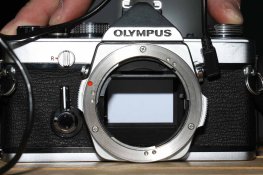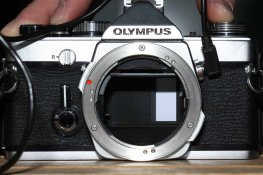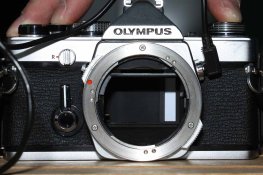Buzz-01
Member
Hi all,
My first post on this form after reading for quite a while. Short introduction:
I have been shooting film with some basic point-and-shoot cameras in the 1990s and early 2000s and when things became affordable I switched to shooting digital somewhere in the early 2000s.
Recently I started shooting with film again, using my late father's Olympus OM-1 camera and Metz 45CT1 flash.
I have replaced the light seals of the camera and made an adapter ring to be able to use a hearing-aid battery, ordered a new battery basket for the flash and put in some fresh NiMH cells.
All (except flash) appears to work perfectly fine.
Until now I have been using the camera without flash exclusively for shooting available light and I thought it would be nice to also be able to use the flash with this camera. Especially since it's winter time again.
Because I never really shot with this type of auto electronic flash before, I made an adapter cable with optical isolation to the hot-shoe adapter, so I could use this High Voltage flash safely on my Canon EOS 50D.
So I set up a scene with a subject on a small table and used my 50D to test-shoot the scene. The 50D can sync up to 1/250th sec, but exposure-wise things should be the same.
My OM-1 was loaded with ISO200 film, so I set up:
- The Metz flash to match ISO200 and f/8.
- The EOS 50D to ISO200, shutter 1/60 and f/8.
- In both cases, the flash is connected using a hot-shoe adapter, so not directly on pc-sync port of the cameras.
- Not really relevant for the issue, Focal length on 50D lens set to approx. 35mm to match my 50mm Zuiko lens.
With the 50D I got a perfectly fine exposure, so I dialed in the same parameters on my OM-1 and took the same shot with the flash:

Clearly something went wrong here, to me this looks like some sort of sync problem.
My first thought would be:
- Either I did not set shutter speed slow enough (<= 1/60th sec)
- or the fp/x switch could have been set to fp
- or there is something wrong with my OM-1
When browsing through my dad's old negatives, I found several shots taken in the late 1970s / early 1980s with the same sync issues. Therefore, it's also quite well possible that something's wrong with my camera or flash.
I specifically made sure that shutter speed was set to 1/60th and that fp/x was set to x before I took the shot.
Also, I remember reading somewhere online that fp/x switch would only be applicable to pc-socket, and that hot shoe would always be x-sync. Unfortunately I can't remember where I read that.
On this web page (and in the user manual), they explain something about Electronic flash being synced at 1/60th or slower and MF / MF:FP being synced at 1/15th or slower.
But what is the difference between Electronic Flash and MF / MF:FP in regard to my Metz flash?
I always assumed that the Metz is an Electronic Flash and that I should dial in 1/60th or slower.
Anyone who can point me in the right direction here? Thanks in advance!
My first post on this form after reading for quite a while. Short introduction:
I have been shooting film with some basic point-and-shoot cameras in the 1990s and early 2000s and when things became affordable I switched to shooting digital somewhere in the early 2000s.
Recently I started shooting with film again, using my late father's Olympus OM-1 camera and Metz 45CT1 flash.
I have replaced the light seals of the camera and made an adapter ring to be able to use a hearing-aid battery, ordered a new battery basket for the flash and put in some fresh NiMH cells.
All (except flash) appears to work perfectly fine.
Until now I have been using the camera without flash exclusively for shooting available light and I thought it would be nice to also be able to use the flash with this camera. Especially since it's winter time again.
Because I never really shot with this type of auto electronic flash before, I made an adapter cable with optical isolation to the hot-shoe adapter, so I could use this High Voltage flash safely on my Canon EOS 50D.
So I set up a scene with a subject on a small table and used my 50D to test-shoot the scene. The 50D can sync up to 1/250th sec, but exposure-wise things should be the same.
My OM-1 was loaded with ISO200 film, so I set up:
- The Metz flash to match ISO200 and f/8.
- The EOS 50D to ISO200, shutter 1/60 and f/8.
- In both cases, the flash is connected using a hot-shoe adapter, so not directly on pc-sync port of the cameras.
- Not really relevant for the issue, Focal length on 50D lens set to approx. 35mm to match my 50mm Zuiko lens.
With the 50D I got a perfectly fine exposure, so I dialed in the same parameters on my OM-1 and took the same shot with the flash:

Clearly something went wrong here, to me this looks like some sort of sync problem.
My first thought would be:
- Either I did not set shutter speed slow enough (<= 1/60th sec)
- or the fp/x switch could have been set to fp
- or there is something wrong with my OM-1
When browsing through my dad's old negatives, I found several shots taken in the late 1970s / early 1980s with the same sync issues. Therefore, it's also quite well possible that something's wrong with my camera or flash.
I specifically made sure that shutter speed was set to 1/60th and that fp/x was set to x before I took the shot.
Also, I remember reading somewhere online that fp/x switch would only be applicable to pc-socket, and that hot shoe would always be x-sync. Unfortunately I can't remember where I read that.
On this web page (and in the user manual), they explain something about Electronic flash being synced at 1/60th or slower and MF / MF:FP being synced at 1/15th or slower.
But what is the difference between Electronic Flash and MF / MF:FP in regard to my Metz flash?
I always assumed that the Metz is an Electronic Flash and that I should dial in 1/60th or slower.
Anyone who can point me in the right direction here? Thanks in advance!

















 )
)

